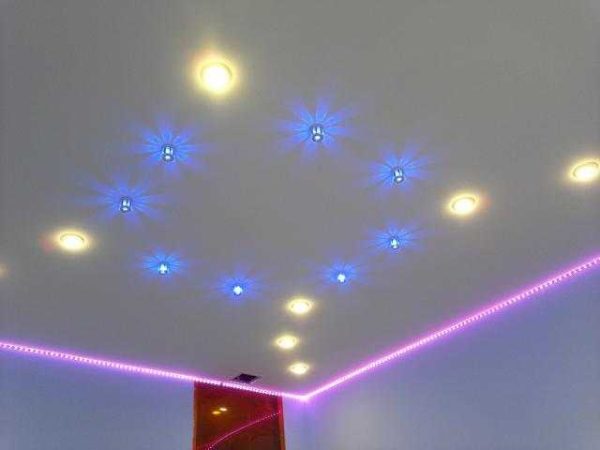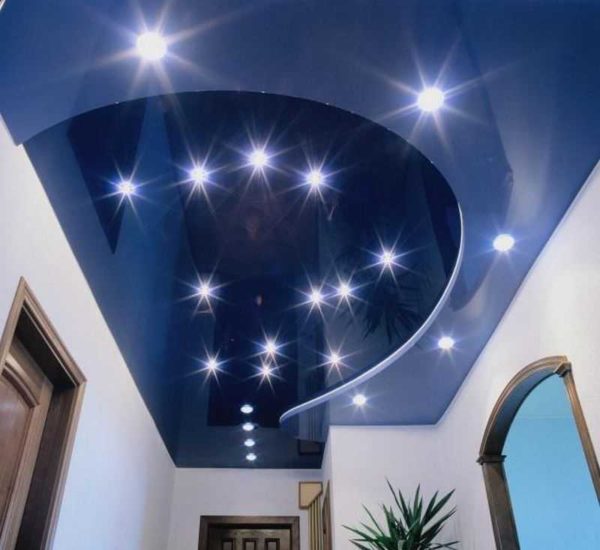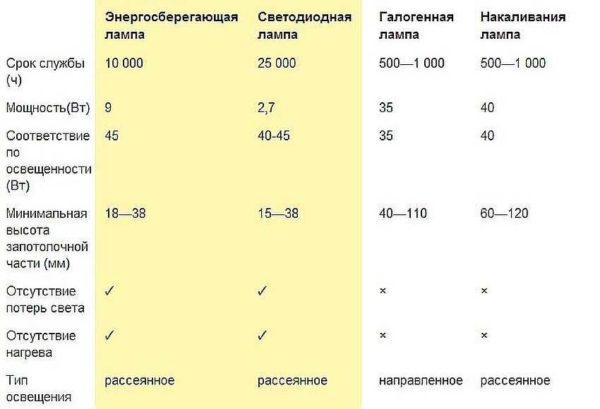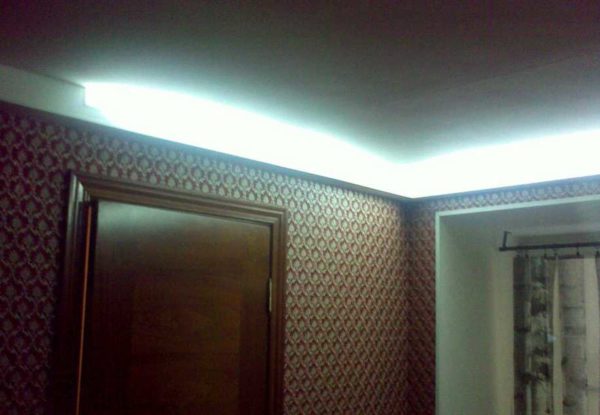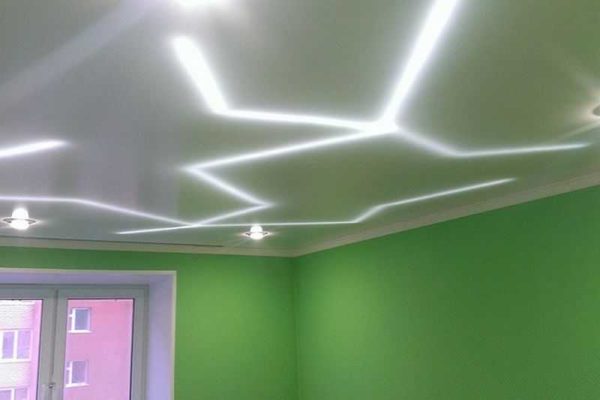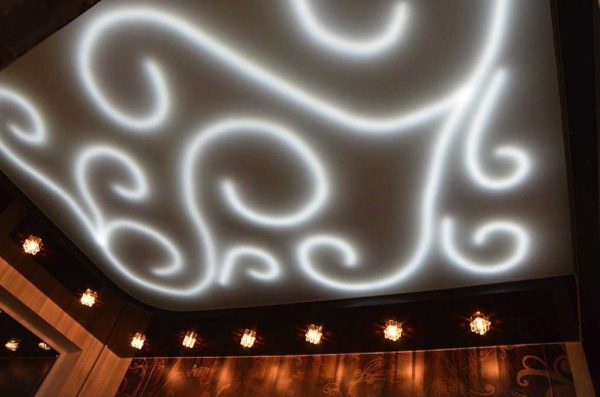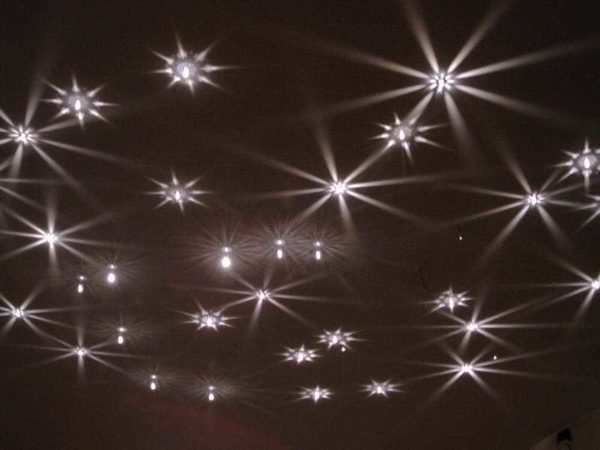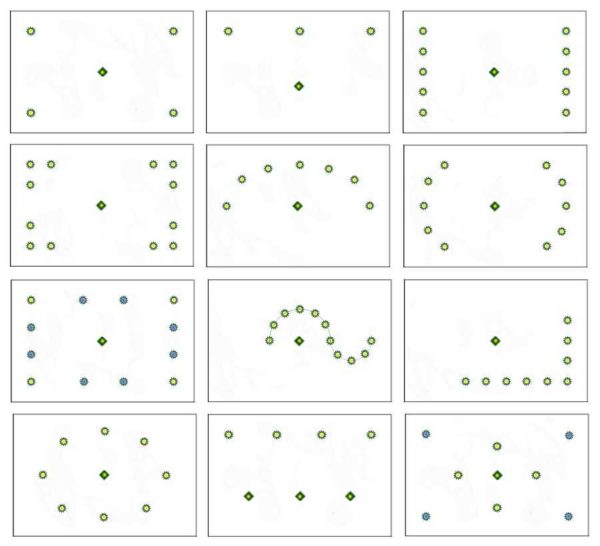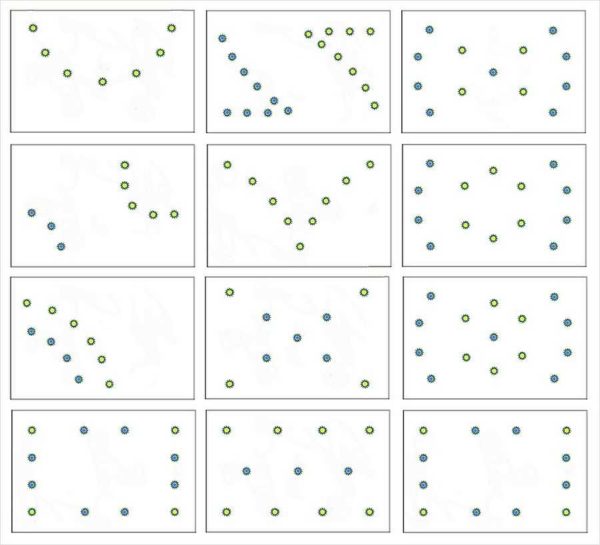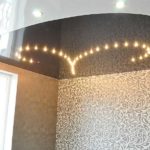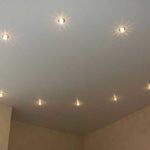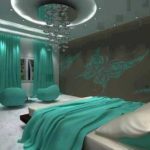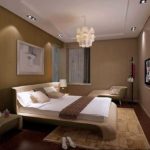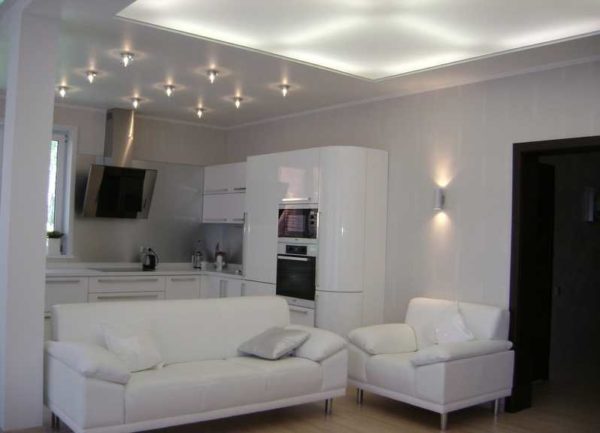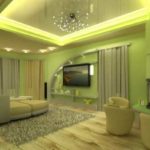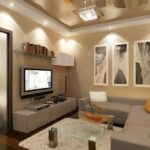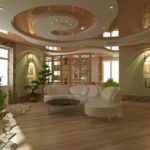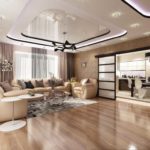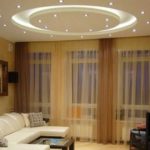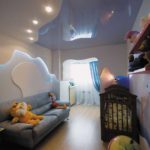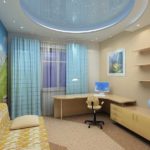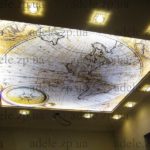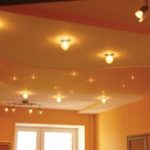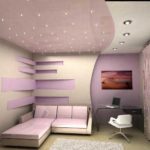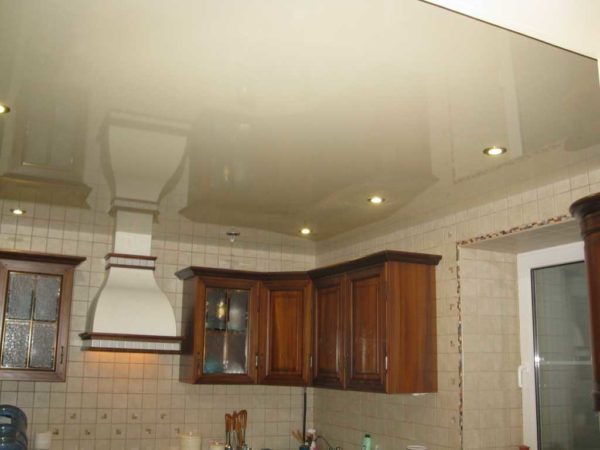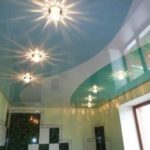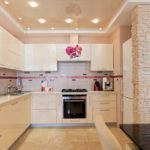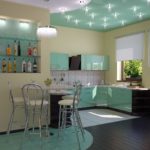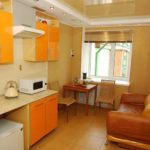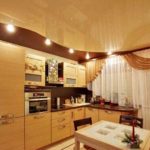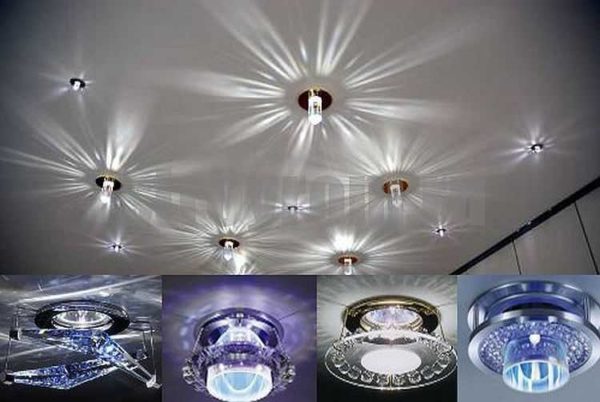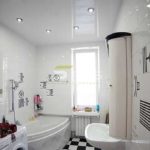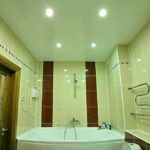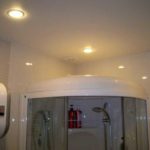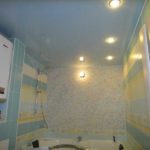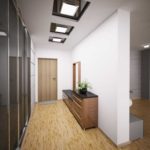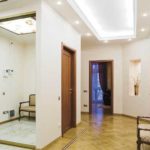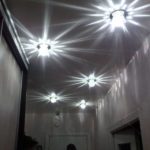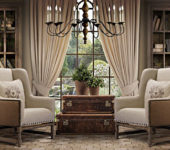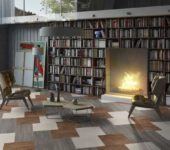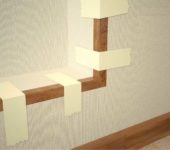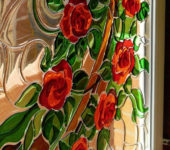How to place fixtures on the ceiling
The correct design of the ceiling allows you to create a harmonious design, but in addition to the flow itself, it is necessary to properly organize the lighting. And this is an even more difficult task - it is necessary to take into account the need for light, as well as choose the location of the lamps on the ceiling so that all this looks beautiful, organic and does not strain the eyes.
The content of the article
A bit of theory
In recent years, the lighting of premises in houses and apartments usually consists of two components - a chandelier, as the main source of the bill, and small spotlights that create a certain atmosphere or additionally illuminate some areas in the room. In some cases, wall lamps and / or table lamps, floor lamps are added. But the basis is usually the ceiling lighting.
Traditionally, the location of the chandelier is strictly in the center of the ceiling. Very rarely deviate from this rule - then it is too difficult to create a harmonious design. An exception is the combined space in studio apartment or kitchen-living room... In this case, a chandelier (usually one) is placed in the center of one of the zones, the rest are illuminated by spotlights or other light sources. In this case, it is necessary to choose the location of the lamps on the ceiling taking into account the design and geometry of the room. It's not that easy.
Rules for placing spotlights
The location of spotlights on the ceiling is a matter of imagination and taste, but you should not neglect the technical nuances. First, they must be placed taking into account the required illumination of various parts of the room: more light is usually needed above the table, maybe above the seating area, etc. Although, if necessary, you can "pick up" the missing brightness using floor, desktop or wall options. Secondly, it is necessary to install spotlights in accordance with safety requirements. Especially it concerns stretch ceilings... They are made from materials that are sensitive to temperature, and since most lighting fixtures are heated, this must be taken into account.
Recessed spotlights are also called spots. This name is not so widespread, but it is also found.
Here are the guidelines for installing spotlights on the ceiling:
- When placed along a wall, the minimum distance is 20 cm. If placed closer, the light is poorly scattered, and there is a likelihood of "overheating" nearby walls.
- The minimum distance between two luminaires is 30 cm, but in general, it depends on the design, the type of installation, the material from which the ceiling is made.
In general, these are all general restrictions. They concern both plasterboard and ordinary - bleached or painted - ceiling. Only tensioners have their own characteristics. We will talk about this further.
Features of using built-in luminaires on stretch ceilings
The main nuances are due to the fact that the materials from which stretch ceilings are made do not tolerate strong heating. Therefore, there are restrictions on the maximum power of the lamps used:
- put on the PVC film
- incandescent lamps up to 40 W;
- halogen - up to 20 W;
- on satin
- incandescent lamps up to 60 W;
- halogen - up to 35 W.
Despite the fact that the power of the recommended lamps is different, the illumination will turn out to be almost the same, since halogen light gives more.
Another type of lamps that are used to illuminate a stretch ceiling is LED. There are no power restrictions - they practically do not heat up. But there is another "but" - a special adapter is required to power such lamps, but it heats up. But the good news is that it can power a sufficiently large number of bulbs. Well, it is better to place it not on the ceiling, but in an accessible place - for easier repair or replacement.
What else can be used to illuminate the ceiling
The next type of lamps is fluorescent. They are used quite infrequently - they look, to put it mildly, "not quite", and their dimensions are solid. Only the view is spoiled. They can be mounted on the walls behind the stretch ceiling. In this case, the effect is very interesting - the diffused illumination is more intense near the walls, smoothly descending to a minimum in the center.
In addition to fluorescent lamps, there are long LED lamps. They can also be used for covert lighting. This option is even better. Firstly, because LEDs have a longer service life, secondly, they practically do not heat up, and thirdly, they give an even stream of light without flickering inherent in fluorescent light sources. There are two disadvantages of LED lighting. The first one has already been voiced - special power supplies are needed. The second is the high price for the lamps themselves and the power supplies for them. But you can create very interesting compositions that are difficult to organize with other light sources.
There is also their subspecies - economy lamps. They have a base like conventional ones, with the same power consumption they give more light, but they have large dimensions and do not have the ability to focus the light stream.
What else can be used to illuminate the ceiling - neon tubes and LED strips. It is quite difficult to work with pipes, but led strip connect you can do it yourself. Thanks to their flexibility, you can create interesting compositions.
There is one more requirement for the location of the lamps on the ceiling made of film - the minimum distance from the light source to the seam is 15 cm. It is impossible to get any closer, since the joint may disperse when heated.
How to calculate the required number of spotlights
When developing a circuit, the question always arises: how many lamps are needed. In general, it is believed that lighting one square meter of floor area requires 20 watts. When calculating, you need to consider how much lamp power you plan to use. If it is 30-35 W, then it turns out that one lamp can illuminate 1.5 squares (30 W / 20 W / m2 = 1.5 m2). Further room area divide by 1.5, you get the number of fixtures that need to be installed for normal illumination. In this case, there will be enough light for full lighting.
When drawing up a scheme for placing lamps on the ceiling, this number can be slightly adjusted in both directions, adjusting to the type of room. For example, for a bedroom, the number can be reduced - it does not require too bright light, but for a living room, a corridor, you can increase it - here it is just better to have some surplus. True, in this case, it is desirable that the lamps are turned on in parts - it is desirable to vary the degree of lighting. There should be at least two options: full and partial lighting. For this, the lamps - through one or according to some other scheme - are connected to two switch keys.
When used in spotlights incandescent lamps, you can install Dimmer, which will allow you to smoothly change the brightness of the lighting by turning the knob.In general, there are many options. And we have not yet reached the location of the spots on the ceiling.
Location of lamps on the ceiling
For each room, the placement of lamps is developed separately. It is necessary to take into account the geometry of the room, the location of the windows, the needs of different zones in the room. And all this should look beautiful. In general, a rather difficult task and you can only pick it up specifically at the place.
The main options for placing the backlight include a chandelier in the center. Spots are selected in the same style or neutral, not attracting attention.
In some interiors, chandeliers are not used (in small corridors, bathrooms, etc.). In this case, the number of required lamps is calculated according to the above formula and can only be adjusted upward, otherwise it will be dark. Some examples are shown schematically in the photo below.
As you understand, the process is creative, but there are certain recommendations for the location of the lamps on the ceiling for each room. These are not rules and, if desired, they can be broken, but they are formulated on the basis of experience, so that there is a rational grain in them.
In the bedroom
In the bedroom, the setting should be conducive to relaxation and bright light is usually not needed here. It should be soft, unobtrusive, warm. Therefore, choose lamps that give light a little yellowish, but not bright white and not with a blue tint.
- Fantasy curls in one of the corners
- Oval is often used
- Combination of different types of lighting
- Chandelier in the center, square spotlights lined up along the wall
The arrangement of lamps on the ceiling in the bedroom is often done in the form of a circle or an oval. Sometimes the spots are lined up in a straight line along the wall opposite the bed - if there is a TV on it. For a laconic design in a modern style, in the style of minimalism or hi-tech, the classic scheme is suitable - a chandelier in the center, spotlights are lined up along long walls.
In the living room
The living room requires multivariate lighting. At some moments it should be bright, at others it should be muted, sometimes, in general, twilight is required. All this can be done with recessed or surface mounted spotlights. As already mentioned, they are divided into groups and connected to different switch keys. In other situations, a dimmer is installed that changes the brightness of the lamps.
If there are two zones in the living room, their separation can be emphasized with different lighting. You can choose not only different in shape lighting installation schemes, but the devices themselves can be different, give streams of light of different shapes.
If we talk about how to choose the location of the lamps on the ceiling, it is largely dictated by the general style of interior decoration. For romantic styles, ovals, circles, winding lines are more appropriate, for more rigid ones - modern, hi-tech, minimalism - a linear arrangement is better, but along the walls, in the form of the letter X or something else - this is already looking at the situation.
- Another example of zoning with lighting
- For strict styles, it is better to choose a linear arrangement of lamps on the ceiling.
- Sophisticated rounded shapes are suitable for spacious rooms. In a small area, they will "crush" and clutter up the interior
- To emphasize the shape of the room, you can arrange the backlight on the ceiling in squares
- The center of this interior is a sofa, which is emphasized by the composition on the ceiling.
Another tip: in small rooms, you should not implement too complex spot setting schemes. They are good in a large and spacious room. In a small one, it is better to choose a simpler option.Visually raising the ceiling a little will help nested circles, ovals or squares. The effect will increase if you use spotlights in the middle of a slightly smaller size than on the outer perimeter.
Children
The nursery is a rather complicated room in design, since even more diverse lighting will be needed here. The child will need to practice and bright light is required in this area. There is also a play area, in which the illumination should also be sufficient, but a lot of light is not always needed. And the third degree of illumination is when the child prepares for bed. At this time, a subdued soft light is required. Such a difficult task will have to be solved when choosing the location of the lamps on the ceiling for the children's room.
- Ceiling lamps in the nursery should provide enough light
- Most often, if the ceiling is in two tiers or more, recessed lamps are placed along the edge of the "second tier", and a chandelier is installed in the center of the first
- An interesting option with spots around the perimeter of the ceiling
- Multi-zone lighting, and even using lamps of different sizes and powers
- With this arrangement of lamps on the ceiling, there are at least three options for the degree of illumination
If a ceiling is planned in two or more tiers, it is logical to place spotlights along the border of the two tiers. It looks quite organic. If the ceiling is flat, you will have to choose from existing schemes or come up with your own.
Kitchen
The location of the lamps on the stretch ceiling in the kitchen is subject to the same rules - in some areas the lighting should be brighter. In this case, an island of bright light is usually made above the table. Here you can hang a chandelier (or even several chandeliers) on long cords directly above the table.
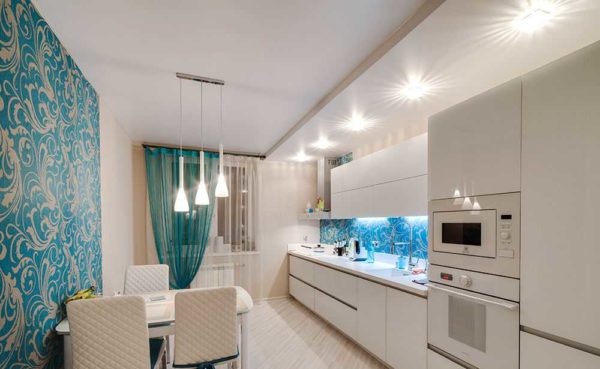
In the kitchen, you can hang a chandelier above the dining table, and illuminate the rest of the area with built-in lamps
The second most common option - the line for installing spotlights on the ceiling follows the contours kitchen set... Only in this case, the lamps should be pushed 15-20 centimeters deep into the room from the edge of the furniture. Then the light will scatter more evenly.
In general, the choice of the location of the lamps on the ceiling depends more on the style of the room as a whole and on the tastes of the owners. If you want to add softness and intimacy to the interior, choose more rounded schemes. If you prefer laconism, geometric patterns are more suitable. You can also play around with the size and type of lamps. A few photos of interesting options for the location of spotlights for the kitchen for you for inspiration.
- Combination of straight and curved lines
- You can play with the sizes
- Clearer highlighting of zones due to lighting
- Rigorously thought-out chaos
- Traditionally - around the perimeter of the room
- Smooth curve gives the interior more softness
Bathroom
It is necessary to carefully approach the choice of lamps for the bathroom: they must have a high degree of protection - they must not be afraid of vapors and splashes. And the choice of location depends on what other light sources you plan to use.
In small-sized ordinary bathrooms, even if they are combined, you can't really accelerate - the area is too small. Then usually two or three lamps are installed above the bathroom or shower cabin and several pieces on the rest of the ceiling area. So that such a scheme does not seem too simple, you can choose interesting lamps or use two types that give beams of light with different patterns.
If the spotlights in the bathroom are installed evenly over the entire area, additional lighting will be needed in the area of the mirror. Otherwise it will be too dark there.Another option is to add a couple of light points in the right place. This should be enough, although for "delicate" operations such as hitting or "working" with a face, directional lighting on the wall is still more suitable.
- Oval or circle is ideal
- In small rooms, you can't fantasize much
- Waterproof lamps
- Plus wall lighting for maximum convenience
Corridor and hallway
Only a few new buildings can boast of a really comfortable and good corridor. In most cases, the corridor is narrow, small and cramped, or long and uncomfortable. It can be straight or in the form of the letter "G", but it differs in that it is very difficult to come up with something intelligible for its normal design. In corridors, the arrangement of lamps on the ceiling is usually linear - along the walls from one or both sides, in the form of the letter "X". It is rare to see a curve like the letter S.
- Complex structures can be done in relatively spacious hallways
- Interesting lamps will help diversify the interior
- Along the perimeter or in the middle along the two most common ways
- Seeming chaos will help make the design more interesting
In square hallways, spots are usually mounted around the perimeter, sometimes complex shapes are made here. Still, in very small areas, simple shapes look better.

